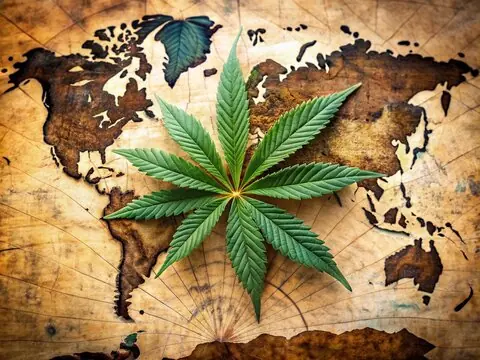
Scientists Have Discovered The Ancient Origins of Cannabis

Tracing the Ancient Roots of Cannabis: New Research Sheds Light on Its Origins and Evolution
For thousands of years, humans have shared a deep and complex relationship with Cannabis sativa. As one of the earliest cultivated plants, cannabis has been valued for everything from its fiber to its psychoactive effects. Yet, its journey from wild flora to domesticated crop is a story that has long remained elusive. Now, groundbreaking genetic research is offering new insights into the mysterious origins of cannabis and how its various forms—hemp and psychoactive strains—evolved into what we know today.
🔬 Decoding the Cannabis Genome
In a recent study, scientists set out to map the genetic history of cannabis by analyzing 110 different genomes collected from across the globe. Using cutting-edge DNA sequencing technologies, they constructed phylogenetic trees to trace how Cannabis sativa diversified over millennia.
The results revealed four genetically distinct groups of cannabis, but perhaps most notably, the researchers identified a previously unknown lineage: basal cannabis. This ancient genetic group is thought to closely resemble the wild cannabis that predated human domestication. Found primarily in local landrace varieties in regions of China—as well as in wild-growing or feral populations—basal cannabis is genetically distinct from both modern hemp and psychoactive strains.
🌏 East Asia: The True Birthplace of Cannabis?
One of the study’s most striking revelations is the likely origin of cannabis cultivation: East Asia, not Central Asia as previously assumed. The researchers estimate that the divergence between basal cannabis and cultivated varieties occurred around 12,000 years ago—the dawn of agriculture during the Neolithic era.
Around 4,000 years ago, the plant branched further, giving rise to the industrial hemp and psychoactive cannabis varieties we recognize today. This timeline aligns with archaeological evidence of hemp-based textiles and tools appearing in East Asian civilizations at that time.
🌍 Cannabis Goes Global
As agricultural practices spread, so too did cannabis. From its roots in East Asia, psychoactive varieties likely reached India by 3,000 years ago, where they became deeply embedded in cultural and religious practices. Over the centuries, cannabis made its way through Africa and Latin America, eventually arriving in North America during the colonial era.
In the 1600s, European settlers brought hemp to the Americas, using it primarily for rope and textiles. By the mid-1800s, Chinese cannabis strains began to replace older European varieties. However, it wasn’t until the 20th century that North America encountered and embraced psychoactive cannabis in a widespread way.
🧪 Limitations and the Path Forward
While the new study marks a major step in uncovering cannabis’s past, it does have limitations. For instance, key regions like Afghanistan and Russia were not included in the genomic sample. These areas are significant in cannabis folklore and likely hold crucial insights into its development.
Additionally, the researchers worked solely with living samples, leaving out dried historical specimens preserved in herbariums, which might have offered even deeper historical data. Legal restrictions have long hindered this type of research—but as global attitudes toward cannabis continue to evolve, opportunities for more comprehensive studies are growing.
🌿 A Plant With a Complex Past—and Future
This new research offers a fascinating glimpse into cannabis’s long and winding history—from wild herb to cultivated powerhouse. By peeling back layers of its genetic evolution, scientists are helping us better understand not only where cannabis came from but also how it adapted to meet the diverse needs of humanity.
As more studies emerge, the story of Cannabis sativa will continue to unfold—rooted in ancient soil, yet growing toward a future filled with new possibilities.
News in the same category


Alan Jackson’s Wild Concert “Command” Sparks Chaos As Fans Rush The Stage

Father who murdered 10-year-old daughter is attacked in prison

Kim Sae Ron Admits To Having Sex With Kim Soo Hyun As A Middle School Student

Depressing find at the bottom of the Mariana Trench is a warning to the world

Paris Hilton’s Unwavering Strength: A Mother’s Defense Against Cruel Comments

What Are Portholes, and Why Are They Used On Cows?

Halley’s Comet Is Back — But This Time, It’s Raining Fire

Found a Hole in Your Tomato? Here’s What It Really Means and What You Should Do Next!

Understanding and Managing Chin Whiskers in Women: Causes, Impact & Solutions

Gynecologist Refuses to Treat Trans Woman, Sparking Backlash Over Refused Care

Flight attendant explains the unexpected reason cabin crew keep their hands under their thighs during takeoff and landing

Little-known mistakes and bloopers in Dukes of Hazzard

Paramedic fatally stabbed by patient he was trying to help during ambulance ride, police say

Man Who Predicted Covid Outbreak Reveals Chilling Warning About New Emerging Crisis

Alarming Health Warning: Experts Say the U.S. Faces Growing Threat from Bird Flu — “We Must Prepare Now”

Jon Bon Jovi reveals how his 36-year marriage to childhood sweetheart Dorothea has stood the test of time

The Truth Behind ‘Durex’: What Its Name Actually Stands For Has Left People Stunned

Stunning Video Reveals Why Your Brain ‘Blinds’ You for Two Hours Each Day
News Post

She Walked Two Miles Every Day So Her Son Could Get to Football Practice. Peyton Manning Found Out — and Bought Her a Minivan.

I DIDN’T MEAN TO STOP AT THE SHELTER—BUT HER EYES WOULDN’T LET ME LEAVE

I PUT HER IN THE SHOPPING CART AS A PUPPY FOR FUN—BUT A YEAR LATER, SHE STILL REFUSES TO WALK INSIDE THAT STORE

I NEVER PLANNED TO DELIVER A BABY ON DUTY—BUT THEN I HEARD THE SCREAMS

MY FIRST DAY AT THE POLICE ACADEMY—AND MY LITTLE SISTER SHOWED UP TO CHEER ME ON

Not a single family member showed for my Biker Grandpa’s 80th birthday

6 Amazing Benefits Of Vaseline & Turmeric For Your Skin

The Power of Cloves and Cinnamon Water: A Daily Ritual for Vibrant Health After 50

DIY Flaxseed Gel & Okra Hair Gel For Hair Growth & Frizzy Hair

12 top hacks for dry skin without spending $$ on meds

12 Thick Eyebrow Growth Home Remedies – Eyebrow Growth Oil & Serum

10 things to always refrigerate & 10 things to never refrigerate

🌿 Health Benefits of Garlic Peel – Don’t Throw It Away!

Natural Teeth Whitening at Home: A Better Alternative

Apple and Cinnamon: A Dynamic Duo for Your Health 🍏🔥

OFFICERS PULLED ME OVER—BUT INSTEAD OF A TICKET, THEY DID SOMETHING I NEVER EXPECTED

Discover the Transformative Power of Castor Oil Before Bedtime

WE THREW OUR K9 HIS 8TH BIRTHDAY—BUT MIDWAY THROUGH, HE LED US TO SOMETHING WE NEVER EXPECTED
